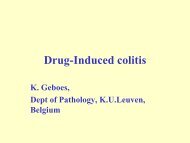The pathology of malaria
The pathology of malaria
The pathology of malaria
You also want an ePaper? Increase the reach of your titles
YUMPU automatically turns print PDFs into web optimized ePapers that Google loves.
Pr<strong>of</strong>essorAhmed A.Mohamedani
Introduction<strong>The</strong> magnitude <strong>of</strong> <strong>malaria</strong>• More than 500 million episodes reported annuallyin Sub-saharan Africa with a death toll <strong>of</strong> more thana million per annum.• In Sudan nearly 35% <strong>of</strong> hospital visits are due to<strong>malaria</strong>• Problem confounded by resistance to insecticidesand drugs.• Variations in modes <strong>of</strong> clinical presentation• Immunity and vaccine development
Introduction• <strong>The</strong> pigment is then phagocytozed by R.E.S.• <strong>The</strong> number <strong>of</strong> RBCs decrease after eachschizogony, whether parasitized or not.• Cell debris , merozoites & their products areset free in the circulation + cytokinesespecially TNF alpha (<strong>malaria</strong> toxins) .• <strong>The</strong>se will act as pyrogenes leading toperiodic chills followed by fever andpronounced perspiration.
Hemozoin andother toxic factorsMacrophageAnd other cellsCytokines and othersoluble factorsFever and rigorsSource: tulane.eduSeverepathophysiology
Changes in the RBCS• <strong>The</strong> parasite produces changes in RBCs:-Size , shape and deformability.-Affects membrane transport .-Parasite-derived proteins produce knobs on RBCssurface(cyto-adhesion)- mainly P. falciparum• This leads to RBCs SEQUESTRATION• <strong>The</strong> end result is SLUDGING , the main pathophysiologicalfactor + other Host factors
Essential malariology
Sequestration• Caused by P. falciparum only- Leads to under estimation <strong>of</strong> disease.-Main causes : loss <strong>of</strong> RBCs deformability +cytoadherence.-<strong>The</strong> latter occurs in capillaries & post capillaryvenules.?Modulated by the spleen. Others:Thrombospondin (platelets),CD36(leucocytes),a membrane glycoprotein and cytokines(TNF)
Possible Host Receptors• CD36• Ig super-family- ICAM-1 (CD 45) intercellular adhesion molecule- VCAM-1 (CD106) vascular cell adhesion molecule- PECAM-1 (CD31) Platelet endothelial cell adhesionmolecule• E-selectin (CD62E) endothelial-leukocyte adhesion molecule1• Thrombospondin 'thrombin-sensitive protein'(TSP)antiangiogenic• Chondroitin sulfate A sulfated glycosaminoglycan (GAG)• Hyaluronic acid• Rosetting Receptors- CR-1 (complement)- glycosaminoglycan- blood group A Source: tulane.edu
Several Parasite Proteins Are Associated with Knobs• KAHRP (knob-associated histidine-rich protein)and PfEMP2 are believed to interact with the submembrane cytoskeleton <strong>of</strong> the host erythrocyte• reorganization <strong>of</strong> the membrane skeleton mayresult in knob formation• PfEMP1 crosses the erythrocyte membrane and isexposed on the surfaceSource: tulane.edu
source:tulane.edu
Sequestrationand cytoadherenceSource: tulane.edu
Source: tulane.edu
Prolonged shock
Falciparum Malaria• Falciparum (malignant) <strong>malaria</strong>:- <strong>The</strong> most serious & causes severe <strong>malaria</strong>- Causes hyperparasitesaemia-With prominent sequesteration (visceral tide)-Sludging & engorgement <strong>of</strong> vessels-Decrease in circulatory volume-anoxia-Common sites affected: spleen, liver, bonemarrow, lungs & brain
Hyperparasitesaemia
WHO definitions for severe <strong>malaria</strong>• Cerebral <strong>malaria</strong>• Severe anemia• Renal failure• Pulmonary edema• Hypoglycemia• Circulatory collapse or shock• Spontaneous bleeding and/or DIC• Repeated generalized convulsions
WHO definitions for severe <strong>malaria</strong>• Acidemia or acidosis• Macroscopic hemoglobinuria (blackwater fever)• Prostration• Hyperparasitemia• Jaundice with vital organ dysfunction• Post-mortem confirmation <strong>of</strong> diagnosis
Abnormal postureRetinal hemorrhageOpisthotonosSource: Essential malariology
Pathogenesis <strong>of</strong> Falciparum <strong>malaria</strong>• <strong>The</strong> main <strong>pathology</strong> (Pf.) is through:(1)Damage & obstruction <strong>of</strong> small blood vessels(2)Damage to endothelium with adhesion & loss <strong>of</strong>fluid(3)Tissue anoxia(4) Anaemia(5) Nephrosis Immunopathological
Malarial Fever• Toxic products <strong>of</strong> parasite + pigment• Release <strong>of</strong> endogenous pyrogenes (TNF+ others)• Pyrogenes act on the hypothalamus leading torelease <strong>of</strong> prostaglandins which act on theposterior hypothalamus stimulatingsympathetic nerves which contract bloodvessels leading to decrease in heat loss.
Cerebral <strong>malaria</strong>• Occurs with falciparum <strong>malaria</strong> only• Pathogenesis not well understood• Capillaries & small blood vessels <strong>of</strong> brain &meninges congested & blocked by parasitizedRBCs• Ring & petechial haemorrhages in sub- corticalwhite matter <strong>of</strong> cerebrum , brain stem andcerebellum= Dürck ‘s glial nodes• Pathogenesis <strong>of</strong> ring haemorrhages in thebrain is poorly understood
Cerebral <strong>malaria</strong>• Stasis leads to anaerobic glycolysis with lacticacidosis• <strong>The</strong> cause <strong>of</strong> the coma is unknown• Cerebral oedema is no longer considered tobe the cause in most cases• Age , geographical location & genotype• Rare cases <strong>of</strong> intra cranial haemorrage arereported (at least one case <strong>of</strong> subdural haem.in a young man (21 years old) with severe<strong>malaria</strong>
Cerebral Malaria• Possible pathogenesis includes:-Vascular causes-Mechanical causes-Metabolic causes(ICAM,CD36,PfEMP1)-Immunopathological causes-Breakdown <strong>of</strong> blood brain barrier-TNF,IL1,IL6 & IL8(Lack <strong>of</strong> IL10)
Neurological Sequelae AmongSurvivors <strong>of</strong> Cerebral Malariaat discharge 23.3%at 1 month 8.6%at 6 months 4.4%van Hansbroek et al (1997) J. Pediatrics 131:125
Malaria & Blood Changes-Anaemia• Severe & rapid with falciparum• In endemic areas affects mainly children &pregnant women• Common in non-immune adults• Common in populations <strong>of</strong> unstable<strong>malaria</strong>• It is the commonest cause <strong>of</strong> anaemia in theworld
Malaria & Blood Changes - Anaemia• Mechanisms <strong>of</strong> anaemia in <strong>malaria</strong>:-Haemolysis <strong>of</strong> parasitized cells-Haemolysis <strong>of</strong> unparasitized RBCs is immunomediatedand Coomb’s positive-Ineffective & dyserythropoiesis-Decreased iron incorporation-Enhanced spleen function(IgG-coating)
Severe anemiaSource: Essential malariology
Malaria & Peripheral Blood Changes• Leucocyte count usually normal or reduced• Neutrophil leucocytosis ? Indicates High TNF• ESR – high• Platelets usually reduced – immune process-Hypersplenism (rarely platelets are parasitized)• Plasma volume usually increased
Malaria & Blood Changes• Coagulation problems:- Deficiency <strong>of</strong> prothrombin-Rapid fall in fibrinogen- DIC may occur-Thrombocytopenia: Platelet-IgG-coating +enhanced spleen uptake & fibrinthrombi entrapping platelets
Black Water Fever• Also known as haemoglobinuric fever• A dangerous complication tending to occur in:-patients previously infected by Pf.-individuals living in endemic areas• Main features: severe chills, rigors, high fever,jaundice with dark red/black urine
Black Water Fever• It is more common in:- fatigued, exposed or injured individuals- Individuals with shock or intercurrent infections-Those taking excessive alcohol-Those receiving inadequate or interruptedquinine therapy
Black Water Fever• Pathological findings:- acute tubular necrosis- accumulating haemoglobin casts- usually parasitessemia is absent at the time <strong>of</strong>diagonsis- Hb itself is not nephrotoxic- but compounds released from RBCs, acidosis& dehydration are incriminated
Black Water Fever• <strong>The</strong>refore the main pathogenic mechanism is:Rapid severe haemolysis followed byHaemoglobinanaemiaIntense jaundiceHaemoglobinuriaAnuriaDeath• Dialysis is life saving and kidney <strong>pathology</strong> isreversible
Sequestration <strong>of</strong>parasites in glomerulusBlackwater feverSource: Essentialmalariology
Some Biochemical Derangements• Hypoglycaemia:-<strong>The</strong> parasites derive their energy solely fromglucose, and they metabolize it 70 times fasterthan the RBCs they inhabit- Quinine may induce insulin release• Lactic acidosis:- Due to anaerobic glycolysis in deep tissues• Hyperkalaemia:- Due to destruction <strong>of</strong> RBC
Acidosis•Multifocal causes•Tissue hypoxia•Liver dysfunction•Impairment <strong>of</strong> renal handling <strong>of</strong>bicarbonate•Wide-spread sequestration inorgans
<strong>The</strong> liver in <strong>malaria</strong>• Enlarged & congested(Sequestration)• It is dark-red,grey or black• Centrilobular necrosis may occur in severefalciparum <strong>malaria</strong>• Parasitised RBCs in sinusoids• Kupffer cell hyperplasia with pigment• Sinusoid macrophages(pig.+parasite)• Sinusoidal lymphocytosis (TSS)
Jaundice• Due to deranged liver function• Impairment <strong>of</strong> bilirubin transport• R.E.System blockade & disturbance <strong>of</strong>hepatocyte microvilli• Haemolysis is an important factor• Severe may lead to liver/renal failure• Attacks decline with repeated infections
<strong>The</strong> Spleen in Malaria• Enlarges ,congested & dark red(All species)• Size varies with duration & degree <strong>of</strong> exposure• In acute stage is s<strong>of</strong>t & tender –easily ruptured, sometimes spontaneously ,in non-immune(Pv & Pf)• Shows RES hyperplasia with parasitized RBCs& pigment-containing macrophages• Plays major role in immune regulation
<strong>The</strong> Spleen in Malaria• Hyper-reactive <strong>malaria</strong>l splenomegaly (HMS) is asyndrome <strong>of</strong> massive, unexplained splenomegalyoccurring in a malarious region.• lassitude, fever, weight loss, hypergammaglobulin(especially IgM), anaemia and cryoglobulinemia.• A clinical response to prolonged anti<strong>malaria</strong>lprophylaxis is diagnostic.• pathogenesis is unclear. In some patients, thecondition will progress to splenic lymphoma withvillous lymphocytes
scarringcryoglobulinemia25°C 4°Cwww.ajtmh.orghepatic sinusoidallymphocytosisIgM revealed byfluorescein-tagging
<strong>The</strong> Kidneys & falciparum Malaria• Renal failure may occur-usually due to extrarenalcauses leading to cortical ischaemia or tubularnecrosis(Algid)• Immunocomplexes cause acute but reversible R.F.• Deposited are Ig (IgM),Compliment &antigens.<strong>The</strong>y clear rapidly with anti<strong>malaria</strong>ltreatment
<strong>The</strong> Kidneys & Quartan Malaria• Quartan <strong>malaria</strong> nephrosis (Nigeria)• Causes a progressive lesion with coursedeposits <strong>of</strong> IgG & IgM + <strong>malaria</strong> antigens inglom. Capillaries• <strong>The</strong>re is albuminuria,decreasing renalfunction & hypertension not responding toanti<strong>malaria</strong>s or immunosuppressants• confirmed by other studies with someshowing schistosomal IgM• Pf-mesangioproliferative(IgM,IgG+Pf-Ags)
Nephrotic syndromesecondary to chronicinfection with P. <strong>malaria</strong>eSource: Essential malariology
<strong>The</strong> lungs & MalariaCauses pulmonary oedemaSometimes precipitated by fluidoverload (Note extrapulmonarycauses e.g. acidosis & CNS troubles)Leading to <strong>malaria</strong> shock lungMay cause septal oedemaMay cause endothelial swelling &hyaline membrane (ARDS) withinthe alveoli
Pulmonary edemaEssential malariology
Adrenals ,GIT, Pancreas & Heart in Malaria Adrenals: congestion & haemorrhages GIT:blood vessels packed with parasites aswell as edema, haemorrhages andulcerations+ malabsorption Pancreas: acute pancreatitis, hypo or hyper-glycaemia Heart: affected mainly by the generalcirculatory changes
Placenta in <strong>malaria</strong>•Severely affected in Pf especially inthe primigravidae (Placental CSA,CD36&Hyaluronic acid)• Exhibits colour and weight changes• Microscopy: parasites in maternal blood, pigmentmacrophages, perivillous fibrin , pigment infibrin & focal cytotrophoblast hyperplasia +membrane thickening.• Abortion, still birth & low birth weight arereported
Who:Laboratory indicators <strong>of</strong> poor prognosis in severe <strong>malaria</strong>HaematologyLeucocytosis>12000/cmmSevere anaemia PCV20% troph. + SchizPigment in >5% neutrophilBiochemistryMajor:Hypoglycaemia, hyperlactaemiaAcidosis & increased serumcreatinineBiochemistryMinor:Total Bilirubin>50 micromol/LLiver & muscle enzymes increased( 3 or more <strong>of</strong> upper limit)Urate increased
Some References from Gezira1. T. E. Taha , R. H. Gray and , A A Mohamedani Malaria & lowbirth weight in central Sudan- American Journal <strong>of</strong>Epidemiology- Vol. 138, No.5, 318-3252. . A. A. Mohamedani, O. Khalafalla , E.A. Ali & A.E. Elsheikh- Spontaneous splenic rupture & Falciparum <strong>malaria</strong> in centralSudan , a report <strong>of</strong> nine cases with review <strong>of</strong> the literature-Journal <strong>of</strong> the Arab Board <strong>of</strong> Medical Specializations Vol. 1,No. 2, April 19993. S.H. A/Rahman, A A Mohamedani,E.M. Mirgani & A.M.Ibrahim- Gender Aspects & Women Participation In <strong>The</strong>Control & Management Of Malaria In Central Sudan- Soc. Sci.Med. Vol. 42, No.10, pp. 1433- 1446 , 1995
4. A. A. Mohamedani, O. Khalafalla , E.A. Ali & A.E.Elsheikh - Spontaneous splenic rupture & Falciparum<strong>malaria</strong> in central Sudan , a report <strong>of</strong> nine cases withreview <strong>of</strong> the literature- Journal <strong>of</strong> the Arab Board <strong>of</strong>Medical Specializations Vol. 1, No. 2, April 19995. I.E. El-Gack, A. A. Mohamedani & O.A. Mirgani-Malaria prophylaxis during pregnancy in primigravidaeusing sulfadoxime/ pyrimethamine in Wad Medani –Sudan.Gezira Journal <strong>of</strong> Health Sciences, September2003, Vol. 1, No.
6. A. A Mohamedani , M.Mostafa & T. E. Taha –Comparison between reported & confirmed <strong>malaria</strong>– Central Sudan7.Adam I., Mirghani OA, Saed OK, Ahmed SM, AAMohamedani, Ahmed HM, Mackenzie CD,Homeida MM, Elbashir MI- Quinine therapy insevere Plasimodium falciparum <strong>malaria</strong> duringpregnancy- East Mediterr. Health J.2004 Jan-Mar;10(1-2):159-66.
8. BAKRI Y. M. NOUR*,MD, PÈTRA F. MENS†,‡,BSc,MSc, OSMAN K.SAEED*,MD, A. A.MOHAMADANI*,MD&HENK D. F. H.SCHALLIG†MSc, PhD- Screening <strong>of</strong> blood bank samples for thepresence <strong>of</strong> <strong>malaria</strong> parasites by conventional methods andquantitative nucleic acid sequence-based amplification (QT-NASBA) assay-Transfusion Alternatives In TransfusionMedicine (TATM), Vol. 9 Issue 2 article 065- 2007.9.B.Y.M.Nour,H.Schallig,P.F.Mens,S.M.Elbushra,O.K.Saeed& A.A.Mohamedani: Use <strong>of</strong> Rapid Diagnostic Tests(RDTs) to monitor the efficacy <strong>of</strong> anti<strong>malaria</strong>l therapy inGezira, Sudan- A prospective assessor-blind comparativestudy-TIJM,Vol2;Issue 3 Jul-Sep. 2009 pp 357-263
10. Frequency Distribution <strong>of</strong> Anti<strong>malaria</strong>lDrug-Resistance Alleles among Plasmodiumfalciparum Isolates from Gezira State,Central Sudan, and Gedarif State, EasternSudan:Menegon, Michela; Talha, Albadawi;Severini, Carlo; Elbushra, Sayed;Mohamedani, A.A; Malik, Elfatih; Mohamed,Tarig; Wernsdorfer, Walter; Majori,Giancarlo; Nour, Bakri American Journal <strong>of</strong>Tropical Medicine & Hygiene - AJTMH-09-0514.R1WARRELL David A., GILLES Herbert M Essentialmalariology, 4th ed.:








